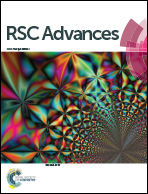Efficient catalyst for tandem solvent free enantioselective Knoevenagel-formal [3+3] cycloaddition and Knoevenagel-hetero-Diels–Alder reactions†
Abstract
In this study a highly efficient catalyst has been observed for tandem solvent free enantioselective Knoevenagel-formal [3+3] cycloaddition and Knoevenagel-hetero-Diels–Alder reactions. Thus, the synthesis of bicyclic tetrahydro-2H-chromen-5(6H)-one and tricyclic octahydro-2H-benzo[c]-chromen-1(6H)-one derivatives with enantioselectivity up to ee 99% has been achieved in the presence of a chiral Lewis acid assisted Brønsted acid (LBA), titanium-isopropoxy-(S)-BINOLate under solvent free conditions. The stereochemistry of the tricyclic product 10 has been further supported by single crystal X-ray analysis. This domino powerful strategy combines both the economic and environmental aspects of organic chemistry, which are necessary for academic and industrial applications.
![Graphical abstract: Efficient catalyst for tandem solvent free enantioselective Knoevenagel-formal [3+3] cycloaddition and Knoevenagel-hetero-Diels–Alder reactions](/en/Image/Get?imageInfo.ImageType=GA&imageInfo.ImageIdentifier.ManuscriptID=C5RA09865C&imageInfo.ImageIdentifier.Year=2015)

 Please wait while we load your content...
Please wait while we load your content...